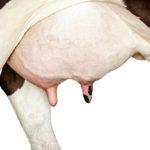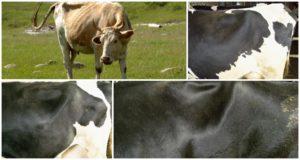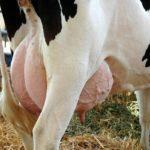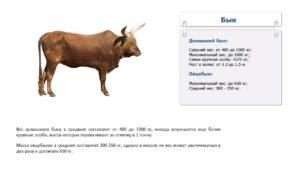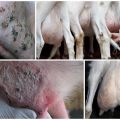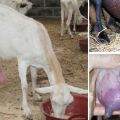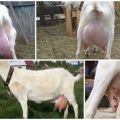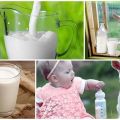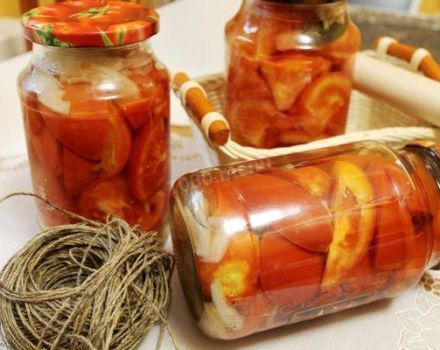The structure and anatomical diagram of a cow's udder, possible diseases
For cattle owners, knowledge about the structure of the udder of a cow, diseases to which the organ is susceptible is necessary. They allow you to properly care for the livestock, maintain the productivity of animals, and promptly respond to emerging problems. Competent milking of first-calf heifers, massage, systematic examinations guarantee the health of the dairy herd and the quality of the products obtained.
How the udder of a cow works
The udder of cattle is located in the groin area. The organ is covered with delicate sparse hairs, in the back of the hairs grow from bottom to top and to the sides and form a "milk mirror", by the size of which one can judge the productivity of the animal. The structure of the udder is complex, the milk production of an animal depends on the interaction of many systems: the digestive, hormonal, central nervous system (central nervous system).
The udder consists of glandular tissue - parenchyma, adipose and connective tissue. The glandular tissue has many alveoli - bubbles, in which milk production occurs, adipose and connective tissues protect the parenchyma from external influences (hypothermia, overheating, bruises and injuries). These tissues are laced with blood vessels. In highly productive animals, the blood vessels are clearly visible under the skin; the amount of milk produced depends on the degree of blood supply to the udder.
Under the influence of hormones (oxytocin, prolactin, estrogen), the alveoli begin to produce milk. It enters the small ducts extending from the alveoli. Small ducts, joining together, form the middle ducts, which, in turn, "flow" into 12-50 large milk ducts, leading down to the milk cisterns of the nipple. The milk cistern is a cavity in the upper part of the nipple, connected to the parenchyma, in which milk accumulates.
The mammary gland consists of 4 lobes, each of which ends in a nipple. Shares are a closed milk production system, they are not interconnected. The right and left lobes of the udder are separated by an elastic septum - a ligament that supports the organ. The posterior lobes are more developed than the anterior ones. In cows that give a lot of milk, the nipples are well developed, they are far from each other, they are 8-10 centimeters long. The nipple consists of a base that passes into the body of the lobe, apex (lower part) and a cylindrical middle part.
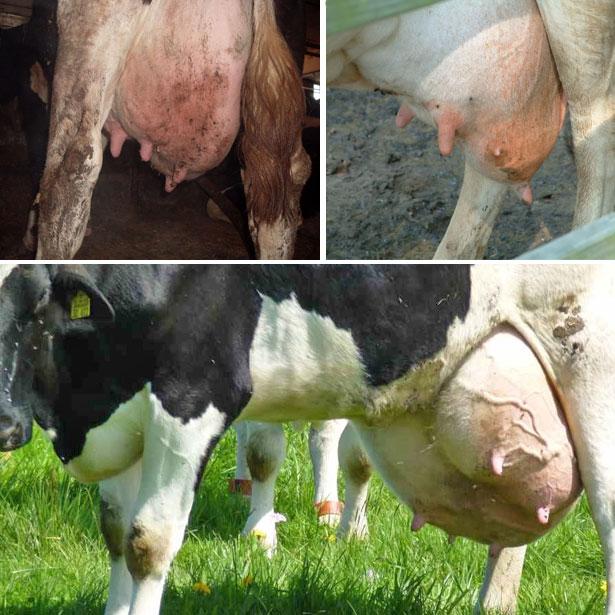
The nipples have many nerve endings; when milking, they become irritated and send signals to the animal's brain, provoking the return of milk. The walls of the nipple are lined with muscle fibers, which form a sphincter at the top of the nipple - a locking device that prevents milk from flowing freely.
Development
The udder of the heifer is laid during intrauterine development.The productivity of an animal depends on genetics, breed, conditions of keeping the heifer, especially in the first months of life. It can be:
- Bath-like. The shape is typical for dairy breeds. Deep, elongated, protruding forward, and looks oval from the side.
- Cup-shaped. The organ is rounded and looks like a deep bowl.
- Goat. Has pendulous posterior and underdeveloped anterior nipples and a prominent lateral groove. Cows with such udders are not suitable for machine milking, the shape is considered a malformation.
- Funnel-shaped. Tapering towards the bottom, with closely spaced nipples.
- Primitive. An underdeveloped organ with large nipples. It is formed if the heifer was poorly fed from birth.
The development of the mammary gland continues with the growth of the animal, but especially increases in the size of the udder in first-calf heifers during pregnancy. Then, over the years (until about 6 calving), the udder continues to increase, then the reverse process begins. Lactation directly depends on the state of the hormonal and reproductive system of the animal.
How milk is made
The lactation process is associated with the processes of digestion, metabolism, blood circulation, respiration. The more glandular tissue the udder contains, the better it is supplied with blood, the higher the productivity of the animal.
Lactation begins with the first calving of the cow. Colostrum and milk are produced for feeding offspring. Milk is produced from products that enter the alveoli with blood, so a huge amount of blood passes through the udder, about 500 liters are needed to form 1 liter of milk. The product in the udders of dairy cows is constantly formed, if the animal is not milked on time, its production decreases, and then completely stops.
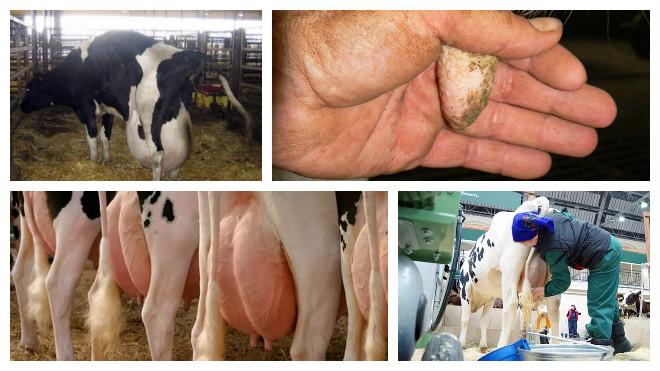
Over time, the cow develops a conditioned reflex, with the sound of a milkman, the sight of a hostess in certain clothes, grooming procedures, milk flow increases. Acetic acid, which forms in the rumen, is responsible for the fat content of milk, the hormonal and nervous systems of the animal regulate its production.
Udder hygiene
The udder performs the same functions as the female breast and should be carefully looked after. The organ must be inspected before each milking. The lobes should be symmetrical, the skin of the organ should be elastic and soft, there should be no bumps and seals in the tissues. Before milking, it is necessary to wash the mammary gland with warm water, use soap in case of severe dirt, then wipe the organ dry with a soft cloth.
Next, you should grease the udder with cream or ointment and make a light massage. To prevent debris from getting into the milk, they wash not only the udder, but also the stomach, sides, and hind legs.
The first drops of milk are milked into a separate bowl to clear the nipple canals. If the animal does not give milk well, repeat the massage during the milking process. Scratches, cracks, udder scuffs must be treated with hydrogen peroxide, after milking, a layer of salicylic ointment is applied. The nipples do not have sebaceous and sweat glands, so the skin on them dries and cracks, the use of creams ("Burenka", "Lyubava", "Zorka") removes the problem.
Possible diseases
Scratches, cracked nipples, small bruises can be treated on their own, if serious problems arise, you should contact your veterinarian.
Mastitis
The inflammation usually occurs after calving. The udder or part of it becomes swollen, hot, and hard to the touch. The cow is worried, loses its appetite, milk yield decreases. There may be traces of blood or pus in the milk. With serous mastitis, the milk takes on a bluish tint, flakes are visible in it.
In this case, the udder is gently massaged, the animal is manually milked 5-6 times a day, and warming compresses are applied to the seals. In severe cases, antibiotic injections are prescribed.
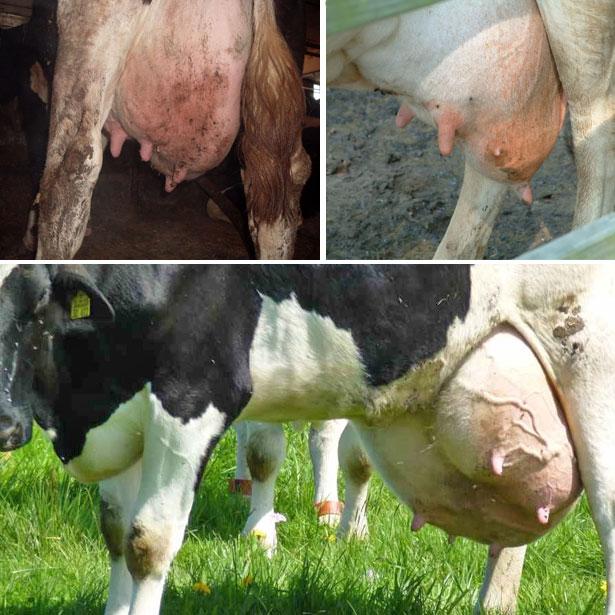
Edema
If it is found after calving, treatment is not required. Frequent hand milking, light massage will relieve the problem. Succulent feed should be excluded, salt should not be given. Lubricate the udder or its individual areas with "Rigofen", bismuth-zinc ointment. In severe cases, prescribe calcium preparations injections, caffeine.
Smallpox
This is a serious infectious disease. The animal is isolated, the veterinary service is called, quarantine measures are observed.
Furunculosis
Treatment requires frequent, 4-6 times a day, washing the udder with clean warm water and soap. Ichthyol ointment is applied to the boils, the skin area is treated with salicylic or camphor alcohol, and streptocide is sprinkled. Furunculosis occurs when cold and high humidity in the barn, non-compliance with sanitary standards.
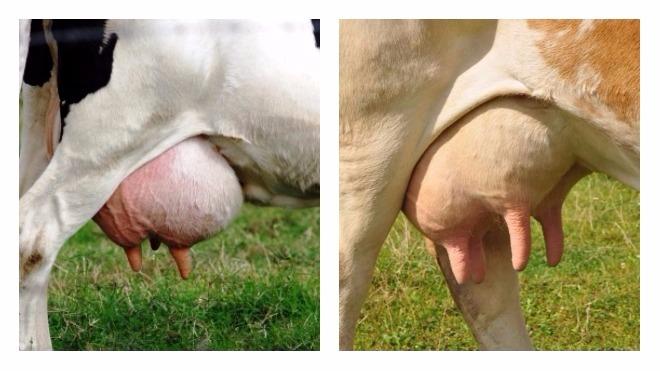
Bruises
The bruise is smeared with iodine, and a cold compress is applied for the first 2 days, then warming ointments. You can use the "Rescuer" remedy for hematomas. It is applied in a thick layer. In severe cases, the area is opened and cleaned from blood clots, and then the resulting wound is treated.
Apply an antibiotic ointment ("Levomikol", synthomycin emulsion). To keep the compresses and napkins with ointment on the udder, put on a bandage.
Insect bites
First, remove the sting with tweezers. A cooling compress is applied to the bite site. Lubricate the bite site with "Rigofen", "Fenistil". On the recommendation of a veterinarian, antihistamines and drugs that support heart function are used.
Warts
In the presence of warts, salicylic ointment, or a mixture of salicylic and interferon ointments, is applied to the affected areas 3-4 times a day. The course of treatment is 1-3 weeks.
To avoid breast diseases, systematic tests for mastitis are carried out, animals are vaccinated, creams and ointments are used to treat the udder. These drugs are available from pharmacies or veterinarians. Good nutrition, maintenance and careful grooming will keep the animals strong and healthy and produce high yields.


